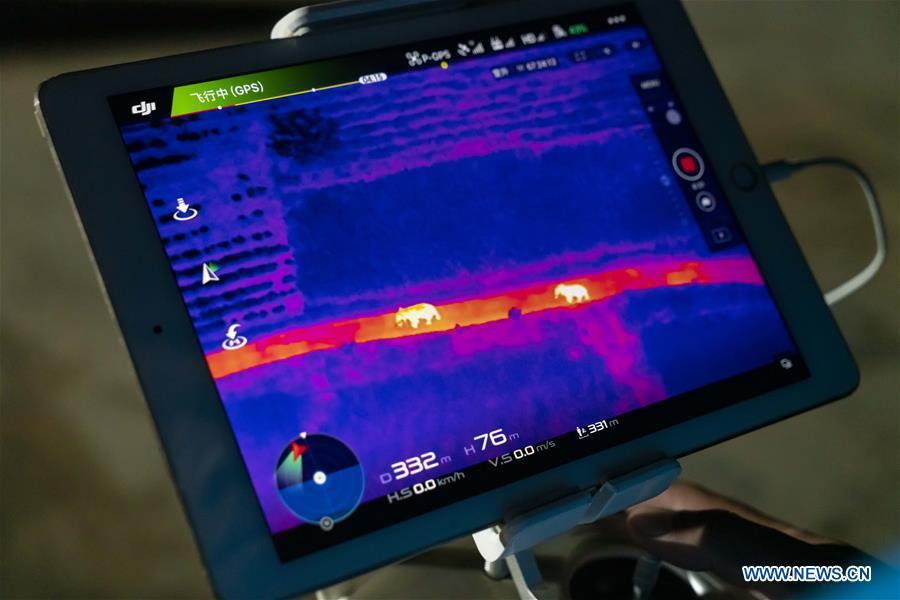China's smart system guards 300 wild Asian elephants
- By Liu Caiyi and Zhang Rui
 0 Comment(s)
0 Comment(s) Print
Print E-mail China.org.cn, August 15, 2020
E-mail China.org.cn, August 15, 2020
A leading smart system is monitoring about 300 wild Asian elephants in Xishuangbanna, Yunnan province.
The Xishuangbanna National Nature Reserve and Inspur Co., Ltd have joined hands to develop a world-leading system for the conservation and ecological protection of Asian elephants. Powered by artificial intelligence (AI), Internet of Things (IoT), big data, and cloud computing, this system enables around-the-clock monitoring of the animals, effectively mitigating human-elephant conflict.

An Inspur spokesperson said that it sets an example of how technology can be leveraged to protect endangered species, promote harmony between humans and nature and drive sustainable development.
The Asian elephant is one of the endangered species in Asia designated by the International Union for Conservation of Nature (IUCN) Red List for its small population size. In 1983, there were only about 193 Asian elephants in China.
With the establishment of the Xishuangbanna National Nature Reserve in Yunnan province and effective conservation measures, the number of Asian elephants in China has grown to nearly 300 in 2020. About 95% of the Asian elephant population live in the reserve, China News Service reported.
Found only in South Asia, Southeast Asia and the southern border of Yunnan province, Asian elephants play a crucial role in protecting wildlife resources in their habitats and maintaining local biological diversity and ecological integrity in tropical forest ecosystems.
As the Asian elephant population grows, the work of the reserve also faces new challenges. On the one hand, more and more Asian elephants are roaming beyond protected areas into human communities, consuming foods, and raiding crops and farm facilities, which exacerbates human-elephant conflicts. On the other hand, the behavior patterns, living habits and ecological environment of Asian elephants that often stray into human settlements are also changing. Scientists need more data to learn about the new habits and behaviors of Asian elephants and provide a scientific basis for long-term conservation strategies.

Traditional observation methods relying on manpower are no longer adequate to meet sustainable development demands. It has become a priority to utilize the power of technology to preserve the elephants, minimize their confrontations with humans and study their evolution in real-time without causing disruptions.
Guo Xianming, deputy director of the research institute at the Xishuangbanna National Nature Reserve, told China News Service on Aug. 12 that the habitat of Asian elephants in Xishuangbanna is a tropical rainforest with complicated landforms and impassable roads, which is not conducive to observation and tracking. Traditional monitoring and prewarning work mainly relies on human observation of elephant feces and footprints. With the assistance of unmanned aerial vehicles (UAVs), they can track the elephant's treading track on foot, predict their paths, and give warning to surrounding residents.
"However, the work mode relying solely on human prewarning is not only a hidden safety hazard, but cannot guarantee all-weather real-time monitoring," Guo continued, "It is easy to misjudge, and there will be delays in the delivery of warning information."
Currently, 300 Asian elephants are protected by the ecological protection system built by Inspur and Xishuangbanna National Nature Reserve. The system collects real-time behavioral data and trajectories of Asian elephants in the rainforest. This technology enables smart identification in milliseconds with an accuracy of over 96%. Even at night, an Asian elephant can be identified by its tail or its back. At present, this recognition accuracy is still improving, and it is at the international leading level.
The system can offer a scientific basis for developing the Asian Elephant National Park, transforming elephant habitats, optimizing food sources, improving crop distribution, and other protective measures. Based on the gathered data, it can provide a useful reference for habitat conservation in the future.
According to the company, since the system was put into operation in May this year, there have been no incidents of casualties due to human-elephant conflict in the prewarning area covered by the system.
This successful use case will be replicated in the future protection of rare and endangered species, such as the Yunnan golden monkey, black-necked crane, muntjac, and other animals. "We strive to inspire a better world through intelligent computing. Humans, animals and nature share the same breath. Technology will unveil a new age of harmonious coexistence," said Peter Peng, CEO of Inspur.






Go to Forum >>0 Comment(s)